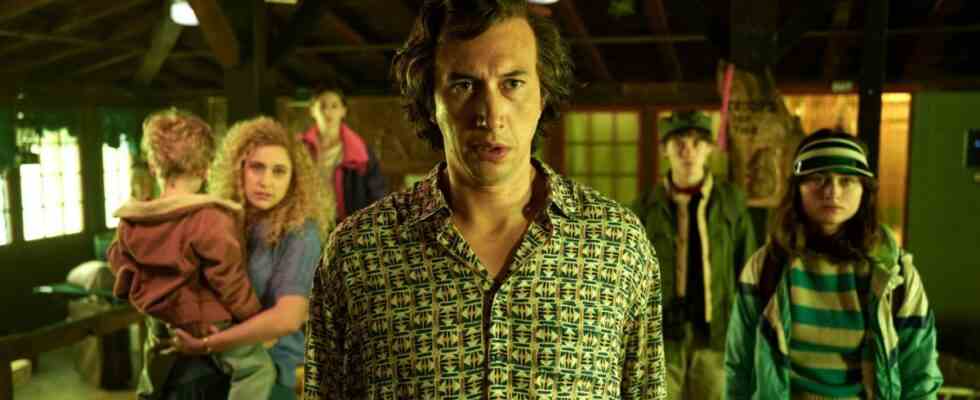The poison cloud is then quite impressive. Deep black and gigantic, it darkens almost the entire sky, the disaster-fighting helicopters buzzing around in front of it appear like tiny insects. Purple lightning flashes inside the deadly gas monster. The people who fled onto the highway in their cars and are now stuck in endless traffic jams stare at the sky in disbelief – a key image in cinema since the invention of the disaster film that seems to have become more indispensable every year.
The director Noah Baumbach, not really known for large-scale epics of doom, but rather for human catastrophes in the family circle (“Marriage Story”), does not want to let go of this attitude in his film “White Noise”. The end of mankind is imminent, you can feel it in every pore in this scene. And yet – ten days later it will all be over. There have been a few casualties, but if the poison continues to work, it will be subtle and invisible. Life in America resumes its normal course.
This mood of going on despite everything, it also goes well with the opening of the 79th “Mostra Internazionale d’Arte Cinematografica” in Venice. After two pandemic editions with strict conditions, which led to fever measurements in front of the cinema entrances, this time you can feel a strong will for normality, which you could also call blissful repression. A loudspeaker announcement still “strongly recommends” wearing a mask during the entire demonstration. But before you know whether someone will follow, the light in the hall mercifully goes out.
Agreeing collectively on how bad an apparent threat actually is – after all, that’s not an easy thing for humanity to do. Noah Baumbach discovered this very contemporary problem in a novel that is now more than 25 years old: Don DeLillo’s great postmodern satire “White Noise”. It features the impressive cloud of poison that one day rises near the sleepy college town in the Midwest where the narrator, Jack Gladney, is a professor of “Hitler Studies” and lives with his large blended family.
A drunk trucker crashes into a freight train carrying highly toxic chemicals, and Baumbach uses his generous Netflix budget to indulge in these images of metal crashing into metal, with force and mass, and sparks flying and a deafening crunch. The venom that erupts, pouring through the cracks slowly at first, then faster and faster before everything explodes and burns, is the color and consistency of blood.
Supermarket shopping as a symbolic act for a full and plump American life
And yet this “Airborne Toxic Event” does not determine everything, neither the novel nor the film. Here the end of the world, which so many stories of the present day permeate with ever new seriousness and pathetic tremolo in the voice, is more of a flirtation. Perhaps that was the mood of the mid-1980s that gave rise to the novel. If it wasn’t about the fear of World War III (which is completely absent here), everything else seemed to be somehow manageable.
Jack Gladney, played by Baumbach regular Adam Driver, is constantly afraid of death, but not so much that he no longer enjoys his family life with his fourth wife Babette and the four children from various constellations who live with them could be: the chaos in the house, the constant chatter at the dinner table, the children’s precocious questions and their arguments, especially the trips to the supermarket together, where tons of stuff always have to be bought, a symbolic act for a full and plump American life.
Here Baumbach succeeds brilliantly in translating DeLillo’s brilliant and unfailingly accurate observations of everyday life into film scenes. In the role of the wife, who constantly addresses her weight, he has his partner Greta Gerwig occupied, causing the character to lose some of its all-important fullness of lush American life. Other things didn’t translate quite so well either: the satire of American campus life with the studies on Hitler and Elvis seems a bit outdated, the universities there now have completely different problems. And the professor friend Murray Siskind, who is allowed to say the most beautiful and cleverest philosophical sentences, is now black (Don Cheadle) for obvious reasons.
Optimism in the midst of a catastrophe: That’s the highly topical “White Noise” spirit
The film opens with Siskind’s lesson on why car accidents in American cinema, despite the deaths they cause, despite the shattered lives and cars and assets, the fireballs and total write-ups, are a fundamental sign of optimism – because they are also for advances in technology stand for the promise that the coming crash will always be more spectacular than the one before it. Using this optimism not only to suppress coming catastrophes, but even when you’re already in the middle of it – that’s the highly topical “White Noise” spirit, which may help to understand the eternal muddling of the present in a completely new way.
“The feeling that we are heading for a total catastrophe does not leave us,” says the narrator at the end of the film. “But we don’t stop inventing hope.” But: Don’t you even have to do that in order to get up in the morning at all? The film dismisses the film experts from all over the world with this open question. How willing they are to invent hope themselves and sometimes ignore dangers is shown by a small final count of the mask wearers in the packed cinema auditorium. At most, about five percent of the viewers still have one on. The rest relies casually on the “white noise” principle.

